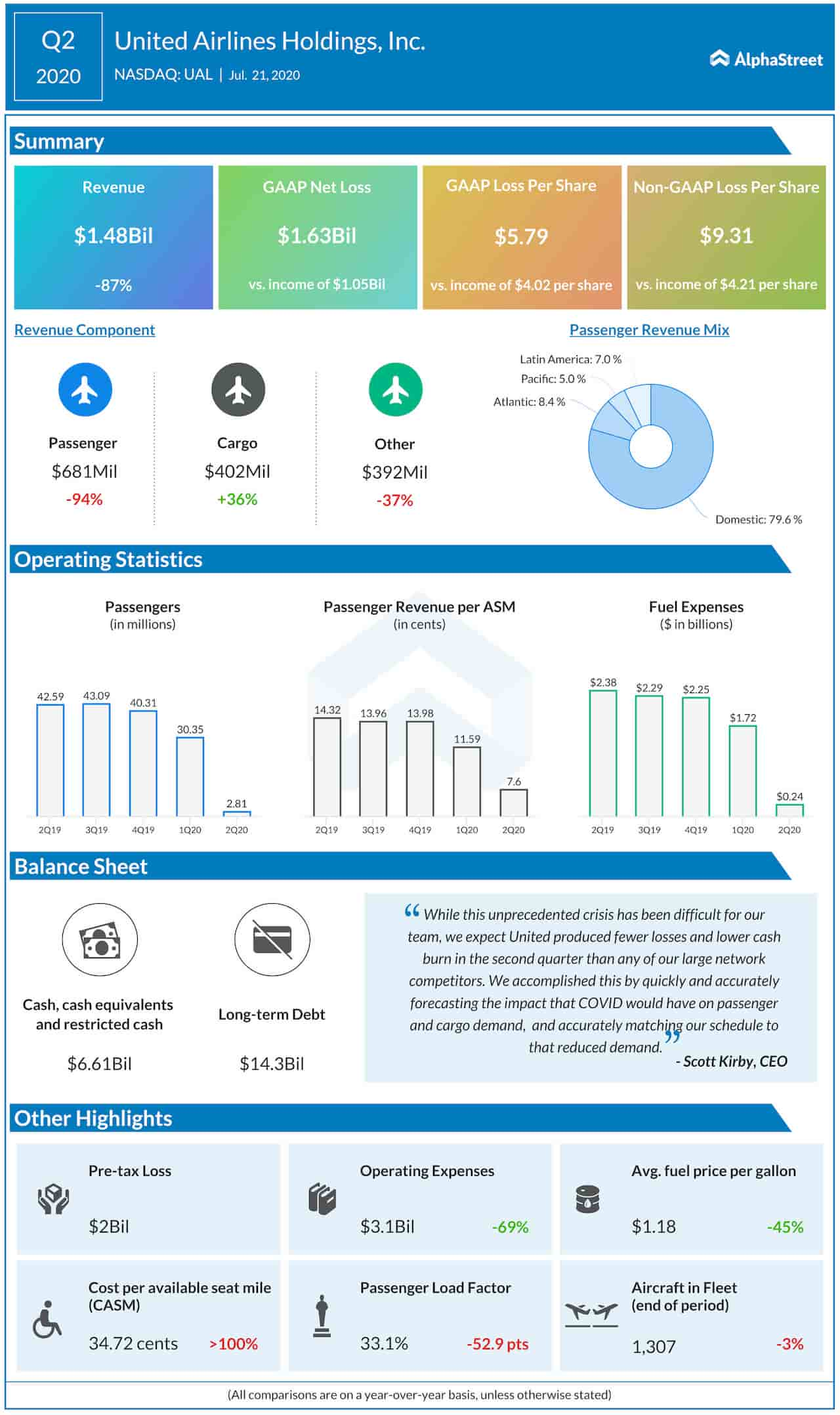Categories Analysis, Other Industries
United Airlines Holdings (UAL) bets on new cost structure to emerge stronger post-COVID
To stop taking delivery of new aircraft until cash position improves substantially
The impact of the virus outbreak on the airline industry has been devastating and worryingly, the current situation shows the troubles of aviation companies are far from over. If the travel restrictions continue, it might take several years for the industry to fully recover from the massive slump caused by the widespread fleet grounding.
[irp posts=”66234″]
United Continental Holdings Inc. (NASDAQ: UAL), one of the worst-hit flight operators, suffered a heavy loss since the onset of the pandemic and its fiscal health remains volatile amid historically low passenger traffic. The near-term projection points to a drop in capacity to one-third of the normal levels in the current quarter. The dismal scenario has prompted the management to embark on a downsizing drive that has rendered several thousands of employees jobless.
Focus on Liquidity
The cost-cutting measures and the resultant reduction in daily cash burn should help the company preserve liquidity and meet its fiscal obligations. Since its exposure to business and international traffic is bigger than most peers, United Holding needs to be prepared for a relatively longer slowdown. Taking a cue from the recent uptick in COVID cases, the management predicts a bigger decline in the third-quarter passenger traffic and revenue than initially estimated.
At $3.37 billion, the revised CAPEX estimate for fiscal 2020 is nearly half of the company’s pre-crisis projection. It has also been decided not to take delivery of any new aircraft this year and postpone all deliveries until the cash position improves substantially.

“Since the start of the crisis we’ve focused on aggressive cost-cutting to minimize our daily cash burn and aggressively pursued opportunities to bolster our liquidity position… We were able to achieve our key objective of raising a substantial amount of liquidity at attractive interest rates in a manner that doesn’t impair our flexibility,” said Gerald Laderman, chief financial officer, United Continental Holdings
Currently, the spotlight is on the cargo business, which saw a steady uptick in recent months. Meanwhile, there is no surety that every aspect of the company’s commercial plans would be relevant in the changing environment.
Is UAL a Buy?
Some investors might find the stock’s low valuation attractive, after the recent selloff, but United Continental remains a risky bet due to the uncertain future that awaits the aviation industry. In general, experts following the stock see a solid uptick later this year, though some analysts are not that optimistic. The stock carries a consensus rating of moderate buy.
United incurred a loss for the second consecutive quarter after the aviation sector ground to a halt a few months ago when the COVID-related travel restrictions came into effect. The company lost a whopping $9.31 per share in the second quarter, significantly wider than the $2.57 per share loss recorded in the first three months of fiscal 2020.
Revenue at Record Low
Considering the lingering epidemic scare, most of the customers either postponed or canceled their travel plans, resulting in a 94% fall in revenues to a multi-year low of $1.5 billion. The only bright spot was that the top-line performance was still better than the consensus forecast.
“While this unprecedented crisis has been difficult for our team, we expect United produced fewer losses and lower cash burn in the second quarter than any of our large network competitors.”
Scott Kirby, chief executive officer of United HoldingsMeanwhile, no surprises are expected when American Airlines (AAL) and Southwest Airlines (LUV) report their quarterly earnings this week. Initial estimates show that the companies incurred heavy losses in the most recent quarter, reflecting the dismal passenger traffic. Last week, Delta Air Lines (DAL) announced its decision to trim the fleet by retiring several of the old aircraft, after reporting an 88% fall in revenues and operating loss for the second quarter.
For more insights about United Continental, read the latest earnings transcript here
After peaking in the final months of last year, United Continental stock had a dismal start to 2020 and is languishing near the seven-year lows seen in March when the shelter-in-place order came. The stock opened Wednesday’s session down and traded lower throughout the session.
Will the Airline Industry Evolve or Die After the Black Swan-ish Disruption?
Is the airline industry staring at an evolutionary cycle after the Coronavirus-induced Pandemic that has no parallels in the past? What was the thought process of top airline executives as Covid-19 unfolded? Were they prepared? What lies ahead? We try to find out from the treasure trove of Earnings Transcripts & Press Releases.
Most Popular
CCL Earnings: Highlights of Carnival Corporation’s Q4 2025 results
Cruise operator Carnival Corporation & plc (NYSE: CCL) on Friday reported an increase in revenue and adjusted earnings for the fourth quarter of fiscal 2025. Earnings topped analysts' expectations. Revenues
Lamb Weston (LW) Q2 2026 Earnings: Key financials and quarterly highlights
Lamb Weston Holdings, Inc. (NYSE: LW) reported its second quarter 2026 earnings results today. Net sales inched up 1% year-over-year to $1.62 billion. Net sales at constant currency remained flat.
Paychex reports higher Q2 FY26 revenue and earnings; EPS beats estimates
Paychex Inc. (NASDAQ: PAYX) on Friday reported stronger-than-expected adjusted earnings for the second quarter of fiscal 2026. Revenues grew 18% year-over-year. The Rochester-based human capital management solutions provider reported revenues